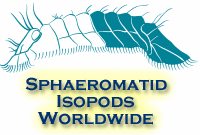| Abstract |
The Cenozoic decapod crustacean fauna from West Japan comprises
153 sp ecies in 90 genera. Selected 142 species in 84 genera of
decapods, one species of a stomatopod, two species in Bathynomus
(isopod), and one species of an amphipod are figured in this volume.
Descriptive remarks, references, occurrences and geologic range for
each species are presented. The following nine species of decapods
are first recognised from Cenozoic deposits in West Japan: Neocallichirus
sp. (Callianassidae) from the lower Pliocene Maja Formation,
Pachycheles sp. (Porcellanidae) from the middle Miocene Mizunami
Group, Epigodromia areolata (Hile) (Dromiidae), Ranilia misakiensis
(Sakai) (Raninidae), Etisus splendidus Rathbun (Xanthidae) and Nursia
speciosa Dana (Leucosiidae) from the upper Pleistocene Ryukyu
Group,Psophelicus sp. aff. P. stridulans Wood^Mason (Goneplacidae)
and Naxioides sp. (Majidae) from the upper Pliocene Kakegawa
Group, and Randallia eburnea Alcock (Leucosiidae) from the upper
Pliocene Masuda Formation and upper Pleistocene Ryukyu Group.
Callianassa bona Imaizumi and Calliax okamotoi Karasawa are transferred
to Neocalllchirus Sakai. Mursia aff. armata de Haan, reported
from the upper Pliocene Kakegawa Group by Karasawa (1993), is
reidentified with Mursia aff. australiensis Campbell, based on newly
obtained specimens from the upper Pliocene Masuda Formation.
Thirty-five decapod assemblages and their palaeoecology are summarised.
The geochronological change of the Cenozoic decapod fauna,
discussed by Karasawa (1993), is slightly modified. |

















